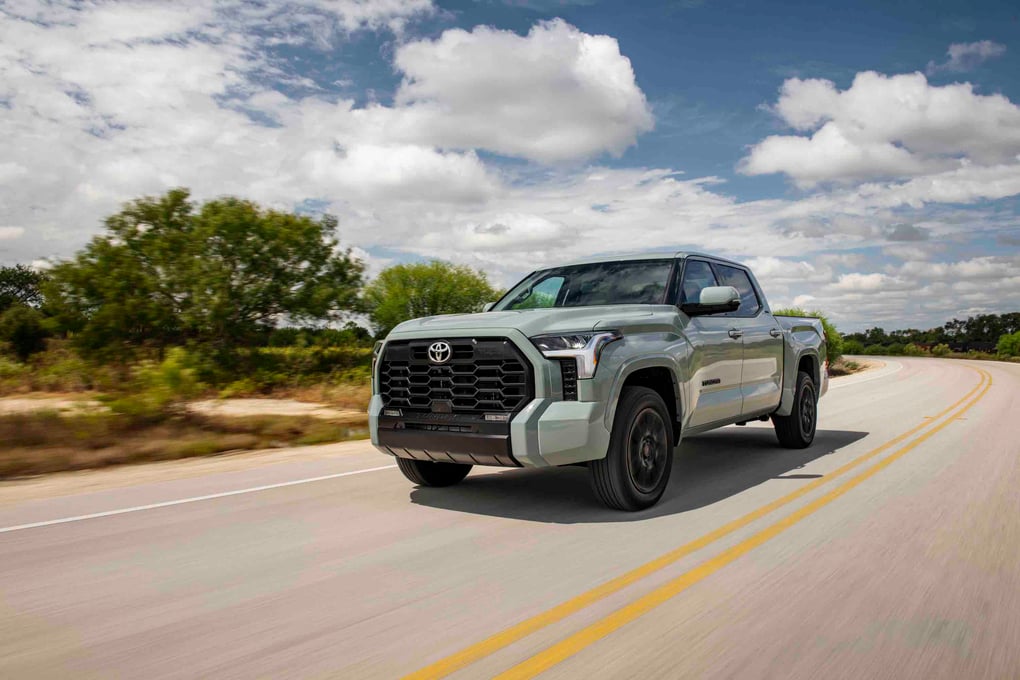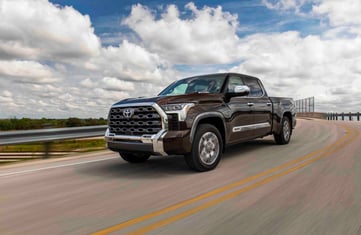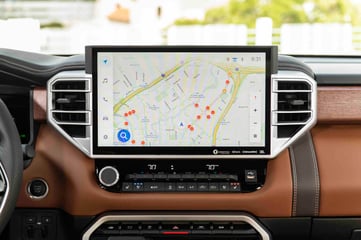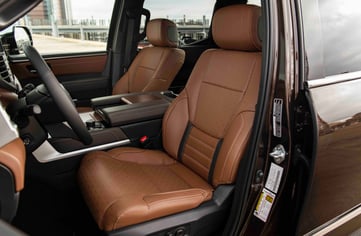The all-new 2022 Toyota Tundra begins rolling out this December and it might take that long to tell you about all the new features and updates. So grab a cup of coffee, get comfortable and read on for all the details in our 2022 Toyota Tundra Guide.
2022 Toyota Tundra
The third-generation Tundra is a hugely important launch for Toyota's well-respected and popular full-size pickup. Toyota really focused on improving capability and ride comfort as well as technology in the new model. It's built on a new chassis and offers new more powerful and efficient powertrains along with improved towing and payload. It's also equipped with a new multi-link rear suspension, offers the Tundra's first-ever available Adaptive Variable Suspension, and along with its new frame comes a new truck bed construction. Technology highlights include the debut of Toyota's new multimedia system along with a new instrument cluster.
Trims, Colors and Configurations
It comes in six trims: SR, SR5, Limited, Platinum, 1794 and TRD Pro. Colors include: Super White, Wind Chill Pearl, Magnetic Gray Metallic, Celestial Silver Metallic, Midnight Black Metallic, Super Sonic Red, Army Green, Lunar Rock, Blueprint, Smoked Mesquite (Limited & 1794) and Solar Octane (TRD Pro exclusive).
The Tundra is offered in two four-door options: Double Cab and CrewMax. Double Cab models will be offered with the choice of a 6.5-foot bed or an 8.1-foot bed. CrewMax models will be offered with either a 5.5-foot bed or a new 6.5-foot bed.
New Chassis
The 2022 Tundra is built on a fully boxed frame, part of Toyota's goal to improve capability and ride comfort. Designers say the fully boxed frame improves rigidity significantly compared to current generation and offers overall improvement in capability. High-strength steel is employed throughout the chassis to increase rigidity considerably over the previous generation. Aluminum use in key areas helps reduce weight. The rear frame member is widened to improve stability and towing capability. Toyota says it also helps with ride comfort and polished handling dynamics, particularly on grades Limited and above where the cabin is mounted to the frame with hydraulic cab mounts. In addition, frame crossmembers are more than doubled in size to provide additional reinforcement and rigidity. A new front cross member was constructed for the steering gear box, which adds rigidity via additional cross member support while enhancing steering input for the driver and handling dynamics.
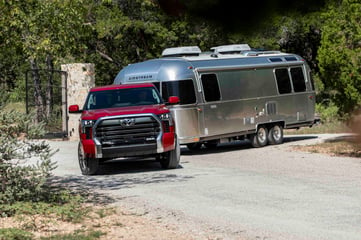
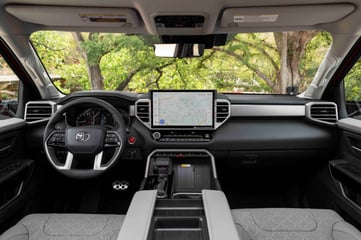
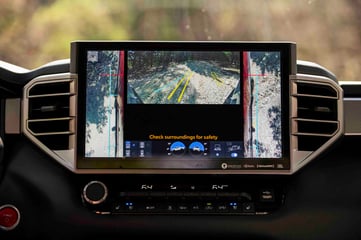
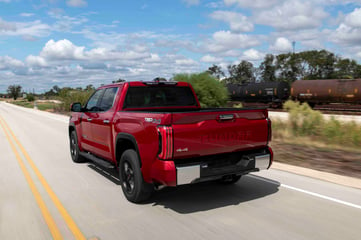
2022 Toyota Tundra Limited TRD Off-Road in Supersonic Red. Credit: Toyota.
The truck bed is lightweight and extremely strong thanks to the new Sheet-Molded Compound construction and the use of reinforcing aluminum cross members in the bed. Toyota says the new bed offers added protection against dents, impact dings and rust compared to traditional steel decks. The tailgate also uses lightweight construction techniques to reduce weight by 20% compared to the outgoing model. A tailgate release located on the key fob is standard on all models.
I-FORCE and I-FORCE Max Powertrains
There are two new powertrains, i-FORCE and the hybrid i-FORCE MAX. Both engines are paired up with a 10-speed Electronically Controlled Automatic Transmission with intelligence (ECTi). It features a sequential shift mode, uphill/downhill shift logic and TOW/HAUL driving modes.
The TRD Pro will only be offered with the i-FORCE MAX powertrain, whereas i-FORCE MAX will be an option on Limited, Platinum and 1794.
i-FORCE
The standard i-FORCE engine is a twin-turbo V6 capable of producing 389-horsepower and 479 pound-feet of torque. (SR grades utilize standard i-FORCE tuning to produce 348-horsepower and 405 lb.-ft. of torque.) The 24-valve, Dual Overhead Cam V6 is chain-driven and features Dual VVTi systems. Toyota says the high-output V6 engine improves on the outgoing V8hanks to the water-cooled intercooler keeping turbo temperatures down, the high-output V6 engine improves on the outgoing V8 engine in every way with impressive performance figures.
i-FORCE MAX
The i-FORCE MAX powertrain is the most powerful of the two new engine options. It pairs the twin-turbo V6 with a motor generator for an additional power boost. The system delivers 437-horsepower at 5,200 rpm, and 583 lb.-ft. of torque at only 2,400 rpm.
Toyota says the i-FORCE MAX powertrain is designed to provide maximum performance and maximum efficiency at every extreme. When towing, the i-FORCE MAX system provides additional power and torque. In city driving, it offers a quiet ride with improved efficiency while in low-speed EV mode.
Toyota says a newly developed Power Control Unit (PCU) is used to achieve excellent battery durability and thermal performance with a focus on drive performance. A 288V sealed Nickel-metal Hydride (Ni-MH) battery resides under the rear passenger seats.
Using the SPORT or SPORT+ settings under Drive Mode Select, i-FORCE MAX makes use of the electric motor’s instantaneous responsiveness. Although the electric motor does the bulk of the work at lower speeds, once above 18 mph the gasoline engine is constantly in operation for excellent performance in the mid- and high-speed range. When in TOW/HAUL mode, the i-FORCE MAX system is constantly in operation to provide impressive acceleration and torque for towing needs.
Fuel Economy
We don't yet know the fuel economy figures for the i-FORCE MAX powertrain. But here they are for the i-FORCE powertrain: On 2WD SR grades EPA estimates for city, highway and combined are 18/24/20, respectively. On all other 2WD grades, the estimates are 18/23/20. On 4X4 models, SR and SR5 grades have estimates of 17/23/19 (city/highway/combined), while Limited, Platinum and 1794 4x4s have estimated ratings of 17/22/19.
New Suspension
The Tundra's new multi-link rear suspension ditches leaf springs in favor of coil springs. Toyota says it improves ride comfort, straight-line stability and overall handling dynamics, along with towing capability. To further enhance the ride comfort, driving performance and overall durability, a newly developed double wishbone front suspension is fitted on Tundra.
Toyota says the new multi-link rear suspension provided the flexibility for the engineers to add Tundra’s new air suspension system to the rear of the truck. The system with automatic and manual leveling functions is available on certain grades. It features height modes for High, Low and Normal.
Adaptive Variable Suspension (AVS) system is also available for the first time on Tundra. It adjusts damping force based on ever-changing road conditions, whether it be a large pothole, bump or small rock. The linear-solenoid-type AVS features built-in actuators in the front and rear shock absorbers to continuously change damping force based on the conditions, all to enhance handling, stability and comfort of the new Tundra.
TRD Pro
For maximum off-road performance, TRD Pro grades are fitted with 2.5-inch diameter FOX internal bypass shocks. The front FOX shocks provide the truck with a 1.1-inch front lift. The aluminum-bodied front and rear shocks feature piggyback reservoirs to house additional oil for improved off-road performance in the most demanding terrain. The shocks use a new polytetrafluorethylene-infused (PTFE) Fox shock fluid to improve on-road comfort. This fluid includes microscopic particles infused with the oil to reduce friction.
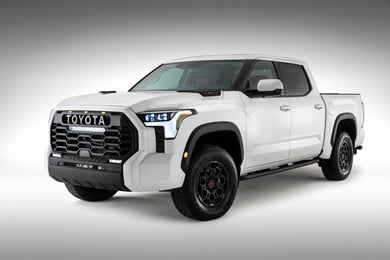
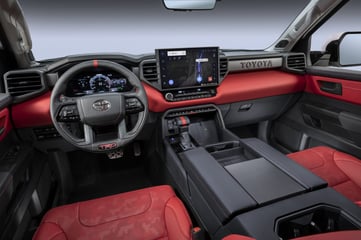
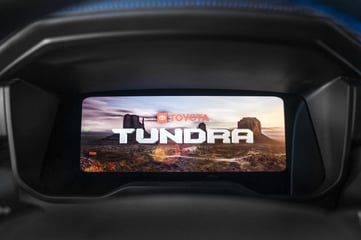
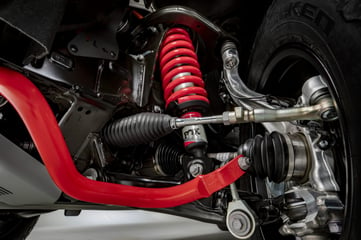
2022 Toyota Tundra TRD Pro. Credit: Toyota.
TRD Pro also gains a few additional off-road attributes, including a new TRD Pro front stabilizer bar, red painted suspension parts, TRD aluminum front skid plate along with additional underbody protection and unique all-terrain Falken tires.
TRD Pro models and those equipped with the TRD Off-Road package also get new standard equipment upgrades, including Multi-Terrain Select, CRAWL Control and Downhill Assist Control which helps drivers navigate tricky slopes by limiting the speed of the vehicle during descent.
Towing and Payload
The maximum towing capacity for Tundra increases 17.6% over the previous generation to 12,000 pounds. The maximum payload increases to 1,940 pounds, which is an improvement of more than 11% compared to the previous generation.
There are also some new features designed to make trailering easier including new haul modes, cameras and trailer guidance. They include new Tow/Haul modes, several new cameras for more exterior angels, new power extending and folding tow heated mirrors with LED trailering lights, and trailer back guidance with a straight path assist feature. Toyota says the available new air suspension system offers the ability to load-level the rear height to find the right balance between truck and trailer.
Technology
The Tundra comes with a host of new technology. It includes the debut of Toyota's new audio multimedia system which features processing power five times greater than the previous generation system, along with an all-new Human Machine Interface.
New Multimedia System
Newly designed standard 8-inch and available 14-inch touchscreen operate more like a phone or tablet, with pinch and zoom as well as improved screen resolutions and more responsive touch functionality. The new system still uses a large, easy-to-grip dial for audio volume and also offers standard wireless Apple CarPlay and Android Auto compatibility.
Other tech features include a virtual Intelligent Assistant and dual integrated cabin microphones. A cloud-based navigation system allows for real-time Over-The-Air updates for mapping and Points of Interest. It also responds to voice-activated commands to search for directions or find points of interest. Google (POI) data ensures up-to-date search capability. Navigation is available to passengers with or without network connection. Wi-Fi Connect offers 4G connectivity for up to 10 devices by turning Tundra into an AT&T Hotspot. A User Profile, stored on the cloud, is accessible through the Toyota App and can recall personalized vehicles settings.
New Instrument Panel
There are two new instrumentation panels on Tundra: an available 12.3-inch TFT panel or a combination meter that includes a 4.1-inch digital multi-information screen (MID) with analog readouts.
The larger screen is standard with the i-FORCE MAX powertrain and on Platinum, 1794 and TRD Pro grades. The 12.3-inch display illuminates when the vehicle is powered on to display one of five rotating Tundra animations. The display features digital gauges like tachometer and speedometer, and other engine performance gauges, along with off-road and towing functions.
Packages
The TRD Off-Road Package is available on SR5, Limited and 1794 models, and it includes 18-inch TRD wheels (unique 20-inch wheels on Limited and 1794), TRD grille, TRD off-road suspension, skid plates, mud guards and TRD leather shift knob, while 4×4 models will also gain electronic rear differential lock, Multi-Terrain Select (MTS) and Crawl Control.
The TRD Sport package is also available on 4×2 or 4×4 SR5 models in CrewMax and Double Cab configurations. It adds 20-inch TRD wheels, TRD grille, TRD lowered sport suspension and a TRD leather shift knob.
Tundra Design
The new Tundra was developed by Toyota Motor Corporation’s North American design studio, Calty Design Research, in Newport Beach, California, and Ann Arbor, Michigan. Designers focused on toughness and capability. The design goal was to capitalize on the modern features of the all-new truck while retaining a nod to the outdoor lifestyle at the core of Tundra owners.
“Our design goal from the beginning was to create the most powerful, rugged and sophisticated looking full-size pickup that will take Tundra to a whole new level,” said Kevin Hunter, president of Calty Design Research. “Because recreation and an outdoor lifestyle are at the core of Toyota truck identity, we set out to create a muscular, chiseled and athletic design that also looks like it could handle the toughest towing demands.”
In the interior, premium materials are used, especially in high-contact areas, which is why wrapped armrests, pads across the dash, door and other areas are employed on most trims.
Toyota says visually the truck needed to represent its capability that lives under the sheet metal.
“We took a fresh, transformational approach to our truck development and had to rethink many things we’d previously done,” said Mike Sweers, senior vice president, Product Development Office, and F1 Platform chief engineer. “Not only did we improve the performance and enhance the capability of this new Tundra, at the same time, we were certain to retain the strong quality, durability and reliability for which Toyota trucks are known.”
Safety
All Tundras come with standard Toyota Safety Sense 2.5 that includes Pre-Collision System with Pedestrian Detection (PCS w/PD) with emergency steering assist, Dynamic Radar Cruise Control (DRCC), Lane Departure Alert, Lane Tracing Assist (LTA), and Automatic High Beams, Road Sign Assist (RSA). Toyota’s Rear Seat Reminder also comes standard on all 2022 Tundras.
Optional safety features include Blind Spot Monitor (BSM), Rear Cross Traffic Alert (RCTA) and available Parking Support Brake which is designed to implement brake control when there’s a possibility of a collision with a stationary object, approaching vehicle, or while parking.
Pricing and Availability
Like the prior generation Toyota Tundra, the new Tundra will be assembled at Toyota Motor Manufacturing Texas (TMMTX) in San Antonio. It begins rolling out next month, but some models won't be available until next Spring.
The Tundra will start from $35,950. Specific pricing will be announced closer to its on-sale date.
You may also like:
Photo Credit: Toyota.
